
The 1876 United States presidential election was the 23rd quadrennial presidential election, held on Tuesday, November 7, 1876. Incumbent Republican president Ulysses S. Grant declined to run for a third term, so the party chose Rutherford B. Hayes, the governor of Ohio, as its nominee. The Democratic Party nominated New York governor Samuel J. Tilden as their nominee. It was one of the most contentious presidential elections in American history. Its resolution involved negotiations between the Republicans and Democrats, resulting in the Compromise of 1877, and on March 2, 1877, the counting of electoral votes by the House and Senate occurred, confirming Hayes as President. It was the second of five U.S. presidential elections in which the winner did not win a plurality of the national popular vote. This is the first time it happened since 1824, and the only time that a candidate has won an overall majority in the popular vote but not won the presidency.
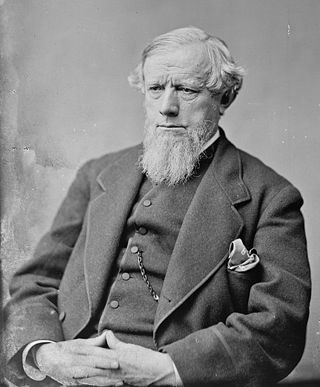
Allen Granberry Thurman, sometimes erroneously spelled Allan Granberry Thurman, was a Democratic U.S. representative, Ohio Supreme Court justice, and Senator from Ohio. He unsuccessfully ran for Vice President of the United States in 1888 with President Grover Cleveland.

Lucy Ware Hayes was the wife of President Rutherford B. Hayes and served as first lady of the United States from 1877 to 1881.
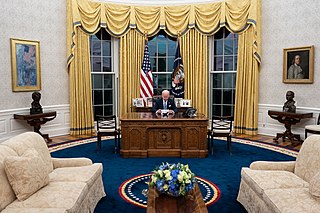
The Oval Office is the formal working space of the president of the United States. Part of the Executive Office of the President of the United States, it is in the West Wing of the White House, in Washington, D.C.

The Compromise of 1877, also known as the Wormley Agreement or the Bargain of 1877, was an unwritten political deal in the United States to settle the intense dispute over the results of the 1876 presidential election, ending the filibuster of the certified results and the threat of political violence in exchange for an end to federal Reconstruction.

Myron Timothy Herrick was an American banker, diplomat and Republican politician from Ohio. He served as the 42nd governor of Ohio and United States Ambassador to France on two occasions.

Thomas Stanley Matthews, known as Stanley Matthews in adulthood, was an American attorney, soldier, judge and Republican senator from Ohio who became an associate justice of the United States Supreme Court, serving from May 1881 to his death in 1889. A progressive justice, he was the author of the landmark ruling in Yick Wo v. Hopkins.
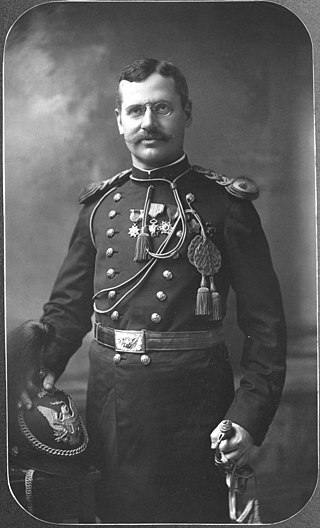
James Webb Cook Hayes was an American businessman and soldier. He co-founded a forerunner of Union Carbide, served in three wars, and received the Medal of Honor.

Cleveland Park is a residential neighborhood in the Northwest quadrant of Washington, D.C. It is located at 38°56′11″N77°3′58″W and bounded approximately by Rock Creek Park to the east, Wisconsin and Idaho Avenues to the west, Klingle and Woodley Roads to the south, and Rodman and Tilden Streets to the north. Its main commercial corridor lies along Connecticut Avenue NW, where the eponymous Cleveland Park station of the Washington Metro's Red Line can be found; another commercial corridor lies along Wisconsin Avenue. The neighborhood is known for its many late 19th century homes and the historic Art Deco Uptown Theater. It is also home to the William L. Slayton House and the Park and Shop, built in 1930 and one of the earliest strip malls.
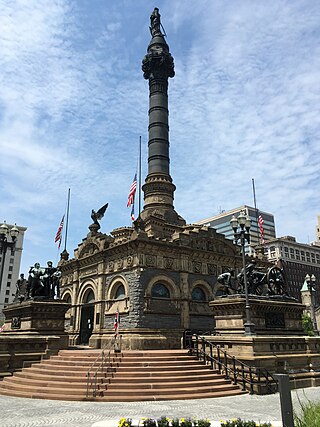
The Cuyahoga County Soldiers' and Sailors' Monument is a major Civil War monument in Cleveland, Ohio, honoring the more than 9,000 individuals from Cuyahoga County who served the Union throughout the war. It was dedicated on July 4, 1894, and is located on the southeast quadrant of Public Square in Downtown Cleveland. It was designed by architect and Civil War veteran Levi Scofield, who also created the monument's sculptures. The monument is regularly open to the public, free of charge.

William J. Simmons was an American Baptist pastor, educator, author, and activist. He was formerly enslaved person, who became the second president of Simmons College of Kentucky (1880–1890), for whom the school was later named.
The National Carbon Company was founded in 1886 by the former Brush Electric Company executive W. H. Lawrence, in association with Myron T. Herrick, James Parmelee, and Webb Hayes, son of U.S. President Rutherford B. Hayes, in Cleveland, Ohio. In 1890, National Carbon merged with Thomson-Houston, Standard Carbon, and Faraday Carbon.
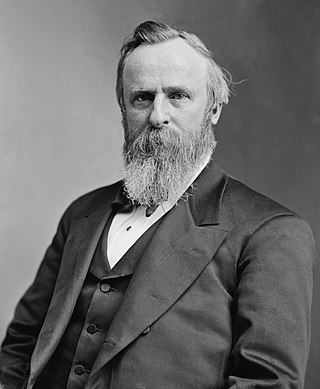
Rutherford Birchard Hayes was an American military officer and politician who served as the 19th president of the United States from 1877 to 1881. During the American Civil War, Hayes served in the Union Army and earned a reputation for bravery in combat, rising up the ranks to serve as brevet major general. After the war, he served in the House of Representatives and as Governor of Ohio before assuming the presidency after his disputed victory in the 1876 presidential election.
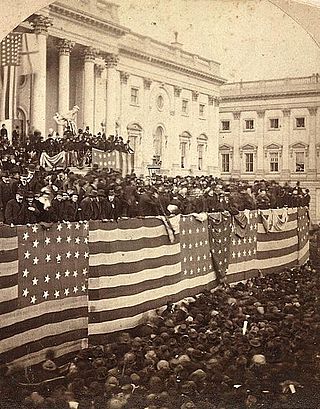
The inauguration of Rutherford B. Hayes as the 19th president of the United States took place publicly on Monday, March 5, 1877, at the East Portico of the United States Capitol in Washington, D.C. This was the 23rd inauguration and marked the commencement of the only four-year term of Rutherford B. Hayes as president and William A. Wheeler as vice president.

David Davis was an American politician and jurist who was a U.S. senator from Illinois and associate justice of the United States Supreme Court. He also served as Abraham Lincoln's campaign manager at the 1860 Republican National Convention, engineering Lincoln's successful nomination for president by that party.

Tregaron Estate, formerly known as The Causeway, is a country house and estate located in the Cleveland Park neighborhood of Northwest, Washington, D.C. The estate, built in 1912, was designed by architect Charles Adams Platt and landscape architect Ellen Biddle Shipman. The original owners, Alice and James Parmelee, lived at the estate from the time of its construction until 1940. From 1942 to 1958, it was occupied by Joseph E. Davies, who had served as United States ambassador to several countries, and his second wife, Post Cereal Company heiress Marjorie Merriweather Post. Today the estate is occupied by a campus of the Washington International School and the Tregaron Conservancy.
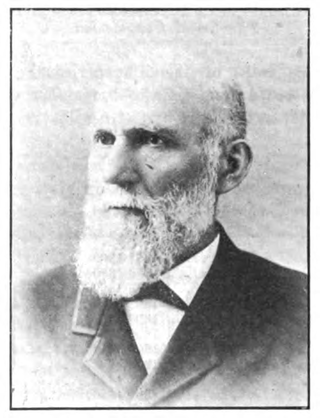
Allen Trimble Wikoff was a Republican politician who was Ohio Secretary of State from 1873 to 1875.

The Regular Issues of 1922–1931 were a series of 27 U.S. postage stamps issued for general everyday use by the U.S. Post Office. Unlike the definitives previously in use, which presented only a Washington or Franklin image, each of these definitive stamps depicted a different president or other subject, with Washington and Franklin each confined to a single denomination. The series not only restored the historical tradition of honoring multiple presidents on U.S. Postage but extended it. Offering the customary presidential portraits of the martyred Lincoln and Garfield, the war hero Grant, and the founding fathers Washington and Jefferson, the series also memorialized some of the more recently deceased presidents, beginning with Hayes, McKinley, Cleveland and Roosevelt. Later, the deaths of Harding, Wilson and Taft all prompted additions to the presidential roster of Regular Issue stamps, and Benjamin Harrison's demise (1901) was belatedly deemed recent enough to be acknowledged as well, even though it had already been recognized in the Series of 1902. The Regular Issues also included other notable Americans, such as Martha Washington and Nathan Hale—and, moreover, was the first definitive series since 1869 to offer iconic American pictorial images: these included the Statue of Liberty, the Capitol Building and others. The first time (1869) that images other than portraits of statesmen had been featured on U.S. postage, the general public disapproved, complaining that the scenes were no substitute for images of presidents and Franklin. However, with the release of these 1922 regular issues, the various scenes—which included the Statue of Liberty, the Lincoln Memorial and even an engraving of an American Buffalo—prompted no objections. To be sure, this series presented pictorial images only on the higher-value stamps; the more commonly used denominations, of 12 cents and lower, still offered the traditional portraits.
National University School of Law was an American law school founded in Washington, D.C. in 1869. Originally intended as part of a larger design for a national university in the United States, the school was the principal component of National University during its existence. The school existed until 1954, when it merged with George Washington University Law School.

















